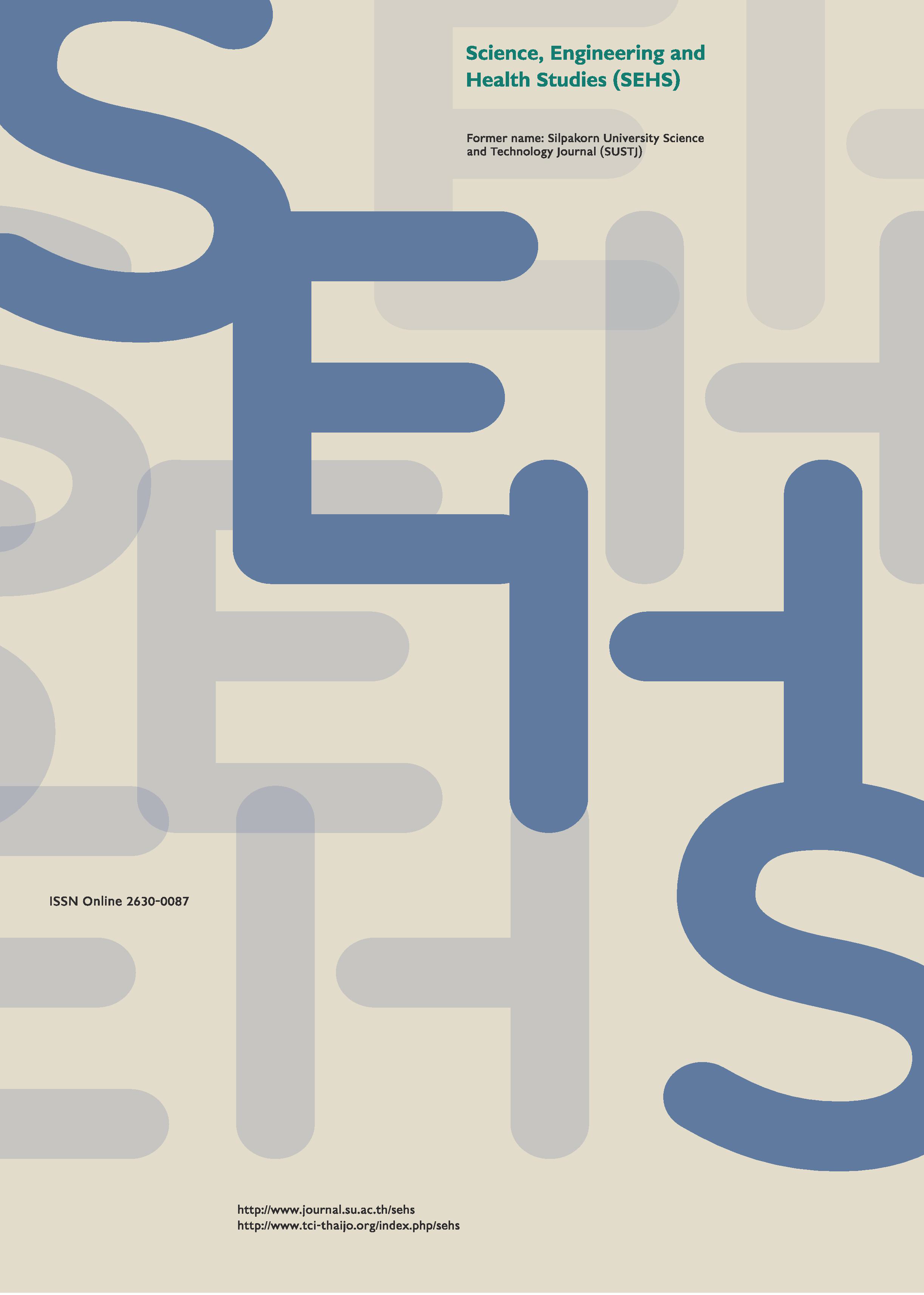Effect of mixing ratios on physical properties and energy consumption of leucaena pellets by using fermented cassava-rhizome
Main Article Content
Abstract
The purpose of this research was to study the effect of mixing ratios of binder on the properties of leucaena (Leucaena leucocephala) pellets. In this study, the fermented cassava-rhizome was used as a binder in the production of leucaena (Leucaena leucocephala) pellets. The duration time of the fermentation process was three days. The mixing ratios of leucaena with fermented cassava-rhizome varied at 90:10, 80:20, 70:30, 60:40, and 50:50, respectively. The results demonstrated that the mixing ratios of binder affected the bulk density and durability of leucaena pellets. The increasing amount of fermented cassava-rhizome increased the bulk density and durability of leucaena pellets. The physical properties were determined following the Pellet Fuels Institute standard specification for residential/commercial densified fuel. Moreover, the results illustrated that the optimal mixing ratios (leucaena: fermented cassava-rhizome) in the production process of pellets was 70:30, as this mixing ratio provided the lowest energy consumption (420 kWh/ton) in pellets production and the highest mass yield at 94.3%. Thus, the results obtained from this research suggested that the fermented cassava-rhizome as a binder might be an alternative adhesive material for improving the asymmetrical structure and physical properties of biomass raw materials
Downloads
Article Details
References
Ahn, B. J., Chang, H., Lee, S. M., Choi, D. H., Cho, S. T., Han, G., and Yang, I. (2014). Effect of binder on the durability of wood pellets fabricated from Larix kaemferi C. and Liriodendron tulipifera L. sawdust. Renewable Energy, 62,18-23.
Barz, M., and Delivand, M. K. (2011). Agricultural residues as promising biofuels for biomass power generation in Thailand. Journal of Sustainable Bioenergy Systems, 21-27.
Berghel, J., Frodeson, S., Granstrom, K., Renstrom, R., Stahl, M., Nordgren, D., and Tomani, P. (2013). The effects of kraft lignin additive on wood fuel pellet quality, energy use and shelf lift. Fuel Processing Technology, 112, 64-69.
Chotchutima, S., Kangvansaichol, K., Tudsri, S., and Sripichitt, P. (2013). Effect of spacing on growth, biomass yield and quality of leucaena (Leucaena leucocephala (Lam.) de Wit.) for renewable energy in Thailand. Journal of Sustainable Bioenergy Systems, 3(1), 48-56.
Garcia-Maraver, A., Rodriguez, M. L., Serrano-Bernardo, B., and Diaz, L. F., and Zamorano, M. (2015). Factors affecting the quality of pellet made from residual biomass of olive trees. Fuel Processing Technology, 129, 1-7.
Gil, M. V., Oulego, P., Casal, M. D., Pevida, C., Pis, J. J., and Rubiera, F. (2010). Mechanical durability and combustion characteristics of pellets. Bioresource Technology, 101(22), 8859-8867.
Hurun, N. Y., and Afzal, M. T. (2016). Effect of particle size on mechanical properties of pellets made from biomass blends. Procedia Engineering, 148, 93-99.
Intagun, W., and Tharawadee, N. (2016). The effect of particle size on the bulk density and durability of pellets: bagasse and eucalyptus bark. Research and Knowledge, 2(1), 74-79.
Intagun, W., Khamdaeng, T., Prom-ngarm, P., and Panyoyai, N. (2018). Effect of core puncture diameter on bio-char kiln efficiency. International Journal of Biotechnology and Bioengineering, 12(11), 435-439.
Izzati, R., Shaari, A. R., Mohammed, A. R., Khor, C. Y., Leng, L. Y., Jamalludin, M. R., and Makhtar, N. L. (2019). Determination of Leucaena leucocephala Sp pellet qualities under different percentage of cassava binders. Journal of Advanced Research in Engineering Knowledge, 7(1), 22-27.
Jiang, L., Yuan, X., Xiao, Z., Liang, J., Li, H., Cao, L., Wang, H., Chen, X., and Zeng, G. (2016). A comparative study of biomass pellet and biomass-sludge mixed pellet: Energy input and pellet properties. Energy Conversion and Management, 126, 509-515.
Kaliyan, N., and Morey, R. V. (2009). Factors affecting strength and durability of densified biomass products. Biomass and Bioenergy, 33(3), 337-359.
Kaliyan, N., and Morey, R. V. (2010). Natural binder and solid bridge type binding mechanisms in briquettes and pellets made from corn stover and switchgrass. Bioresource Technology, 101(3), 1082-1090.
Kanoksilapatham, W., Ogawa, M., and Intagun, W. (2020). Effect of clay and temperature on the slag formation of two biomass fuels: Wood from Acacia mangium and rhizome residual from Manihot esculenta. Renewable Energy, 156, 213-219.
Liu, Z., Liu, X., Fei, B., Jiang, Z., Cai, Z,. and Yu, Y. (2013). The properties of pellet from mixing bamboo and rice straw. Renewable Energy, 55, 1-5.
Liu, Z., Mi, B., Jiang, Z., Fei, B., and Cai, Z. (2016). Improved bulk density of bamboo pellets as biomass for energy. Renewable Energy, 86, 1-7.
Mani, S., Tabil, L. G., and Sokhansanj, S. (2006). Effects of compressive force, particle size, and moisture content on mechanical properties of biomass pellets from grasses. Biomass and Bioenergy, 30(7), 648- 654.
Martin, C., Wei, M., Xiong, S., and Jonsson, L. J. (2017). Enhancing saccharification of cassava stems by starch hydrolysis prior to pretreatment. Industrial Crops and Products, 97, 21-31.
Posom, J., Shreatha, A., Saechua, W., and Siricomboon, P. (2016). Rapid non-destructive evaluation of moisture content and higher heating value of Leucaena leucocephala pellets using near infrared spectroscopy. Energy, 107, 464-472.
Prasertsan, S., and Sajjakulnukit, B. (2006). Biomass and biogas energy in Thailand: potential, opportunity and barriers. Renewable Energy, 31(5), 599-610.
Rattawan, K., Intagun, W., and Kanoksilapatham, W. (2019). Effect of coffee ground on physical and heating value properties of sugarcane bagasse pellets. International Journal of Chemical and Materials Engineering, 13(7), 377-380.
Singh, M. K., Kumar, M., and Thakur, I. S. (2017). Proteomic characterization and schizophyllan production by Schizophyllum commune ISTL04 cultured on Leucaena leucocephala wood under submerged fermentation. Bioresource Technology, 236, 29-36.
Warajanont, S., and Soponpongpipat, N. (2013). Effect of particle size and moisture content on cassava root pellet fuel's qualities follow the acceptance of pellet fuel standard. International Journal of Sustainable and Green Energy, 2(2), 74-79.
Wei, M., Zhu, W., Xie, G., Leatander, T. A., and Xiong, S. (2015). Cassava stem wastes as potential feedstock for fuel ethanol production: A basic parameter study. Renewable Energy, 83, 970-978.
Zhu, W., Lestandr, T. A., Orberg, H., Wei, M., Hedman, B., Ren, J., Xie, G., and Xiong, S. (2015). Cassava stems: A new resource to increase food and fuel production. Global Change Biology Bioenergy, 7(1), 72-83.


